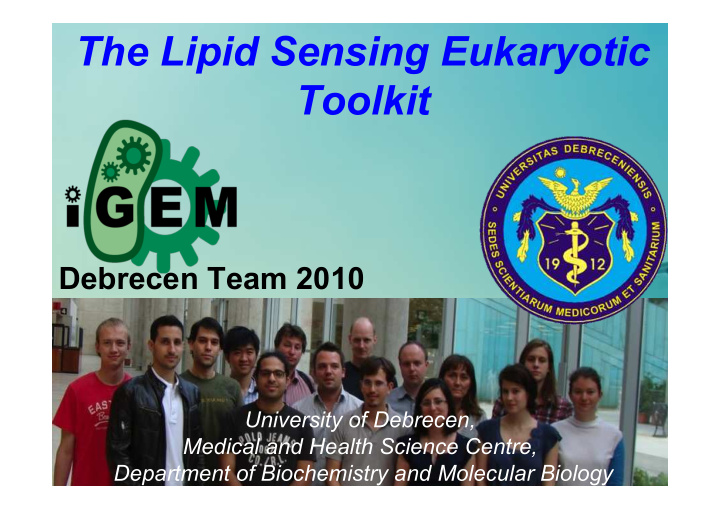



The Lipid Sensing Eukaryotic Toolkit Debrecen Team 2010 University of Debrecen, Medical and Health Science Centre, Department of Biochemistry and Molecular Biology
City of Debrecen (Hungary)
The University Of Debrecen
Objective I Addition of lipid sensing tools to the Parts Registry, which may be used for the rational design of lipid responsive transcription factors Expanding the possibilities of the eukaryote chassis in synthetic biology Debrecen Team 2010
Objective II • Creating a toolkit containing Lipid sensors which may be activated by extracellular lipids and comes equipped with a PoPs (Polymerase Per Second) output DNA binding domains, chimeric receptors, expression vectors and more • Side projects Creating a library of video tutorials for elaboration of basic lab techniques Collaboration with team Edinburgh 2006 (arsenic biosensor) assessment of arsenic contamination in drinking water
Function and structural organization of nuclear receptors a. Function Metabolism Development Homeostasis b. Structure Nat Struct Mol Biol. 2008 Sep;15(9):924-31. Itoh et al.
Nuclear receptors in C. elegans Drosophila 21 Human 48 C. Elegans 284 Robinson et al. J Mol Evol (2005) 60:577–586
Making single part
Results I - Cloning Basic Parts DNA Binding Domains Ligand Binding Domains Estrogen Receptor Constitutive Androstane Gal4 Receptor Retinoic X Receptor Ecdysone Receptor Estrogen Receptor Others Pregnane X receptor TRE-CMV DAF-12 PolyA tail NHR-8, NHR-23, NHR-25 VDR hinge region NHR-31, NHR-64, NHR-80 BAX
Results II - Cloning Chimeric Nuclear Receptors Gal4-PXR LBD Gal4-EcR LBD Others Gal4 - ER LBD ER DBD – VDR Hinge – ER LBD Gal4-C.elegans LBDs
Results III - Cloning Eukaryotic expression vectors TRE-Gal4-PXR -PolyA TRE-Gal4-PXR TRE-Gal4-EcR TRE-Gal4-EcR-PolyA
Results IV – Western Blot anti-Gal4 anti-Actin Confirmation of protein expression proved by WB in transfected 293T cells
Mammalian Two-Hybrid System a. Interaction experiment LUCIFERASE ENZYME b. Ligand testing Detected luciferase activity correlates with ligand binding or strength of interaction
Lipid Extraction Oil sands for testing C. elegans nuclear receptor Diethyl-ether DMSO-ETOH MQ water Over night incubation at 65c After centrifugation and Filtration
Testing receptors in action 1. Activity
Testing receptors in action Dose-dependent activity (pcDNA-Gal-EcR-LBD) 15 10 5 0 no ligand 1 uM 5 uM 25 uM Ponasterone A
Testing receptors in action 2. Dimer formation
Testing receptors in action 2. Dimer formation
Dimer formation of receptors Positive control Gal: in CMX-vector 3500 3000 2500 2000 1500 1000 500 0 VP-RXR Gal-PXR Gal-PXR/VP-RXR Dimer formation of PXR (with RXR) Gal: in pSB1A3-vector Gal: in pcDNA-vector 500 20 400 300 10 200 100 0 0 VP-RXR Gal-PXR Gal-PXR/VP-RXR VP-RXR Gal-PXR Gal-PXR/VP-RXR
Arsenic side project Importance: 10 µg per liter is the WHO threshold for arsenic in drinking water Background: Team Edinburgh, 2006 made an arsenic biosensor, which can be a useful tool for on site arsenic detection Our aim: We tested the system on real samples from South-East Hungary, and the results are the followings
Video Project: “Film in Lab” Recording optimized protocols Uploading the video tutorials to an online source Debrecen Team 2010 http://www.youtube.com/user/debrecenigem2010
In a Nutshell a. Eleven different lipid sensors were designed cloned, tested and added to the parts registry
In a Nutshell a. Eleven different lipid sensors were designed cloned, tested and added to the parts registry b. Our Team has worked to expand synthetic biological possibilities in the eukaryotic chasis by adding a standard (BBF RFC 64) and an expression vector as a composite part
Importance a. Addition of Lipid sensing parts to the parts registry b. Our parts allow the design of complex biological Systems which require defined PoPs input or PoPs titration
Possible application a. Remote control of gene therapy or smart cells b. Synthetic organisms with an environmental “sixth sense” for pollutants
Future directions a. Addition of DNA binding domains to the kit b. Creation of devices and modules which use our parts as input and deliver an apoptosis output synthetic organisms with an environmental “sixth sense” for pollutants c. Develop devices that can be used for screening enviromental lipid contaminanted samples
Recommend
More recommend